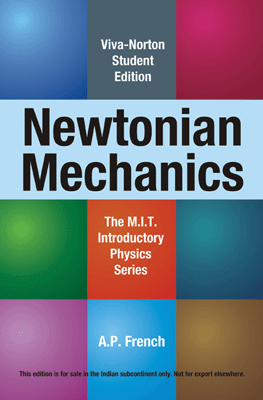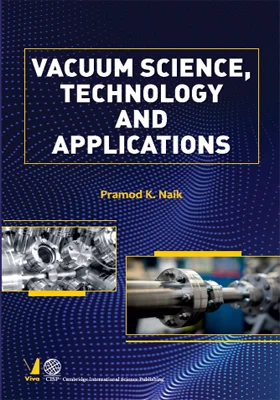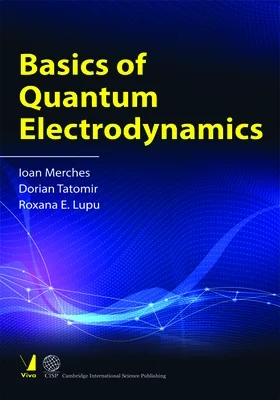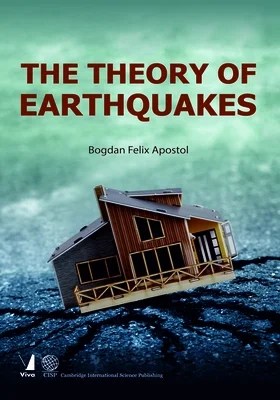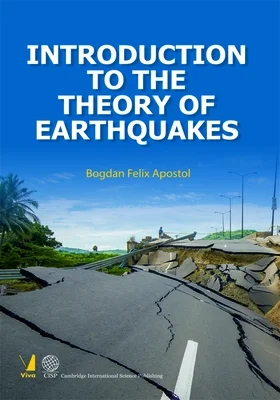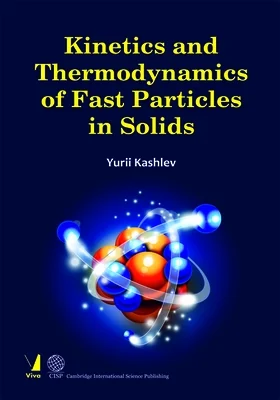Newtonian Mechanics
Newtonian Mechanics
The M.I.T. Introductory Physics Series
₹625.50 ₹695.00 Save: ₹69.50 (10%)
Go to cart-
Out of Stock
ISBN: 9788130917320
Bind: Paperback
Year: 2017
Pages: 760
Size: 153 x 229 mm
Publisher: W. W. Norton & Company
Published in India by: Viva Books
Exclusive Distributors: Viva Books
Sales Territory: India, Nepal, Pakistan, Bangladesh, Sri Lanka
Description:
The text material in the present volume is designed to be a more or less self-contained introduction to Newtonian mechanics, such that a student with little or no grounding in the subject can, by beginning at the beginning, be brought gradually to a level of considerable proficiency.
A rough guide to the possible use of the book is suggested by its division into three parts:
Part I: The Approach to Newtonian Dynamics, is intended to serve two purposes. First, it does discuss the basic concepts of kinematics and dynamics, more or less from scratch. Second, it seeks to place the study of mechanics squarely in the context of the world of physical phenomena and of necessarily imperfect physical theories.
Part II: Classical Mechanics at Work, is undoubtedly the heart of the book. The initial emphasis is on Newton"s second law applied to individual objects. Later, the emphasis shifts to systems of two or more particles, and to the conservation laws for momentum and energy. A fairly lengthy chapter is devoted to the subject that deserves pride of place in the whole Newtonian scheme-the theory of universal gravitation and its successes, which can still be appreciated as a pinnacle in man"s attempts to discover order in the vast universe in which he finds himself.
Part III: Some Special Topics, concerns itself with the problems of non-inertial frames, central-force motions, and rotational dynamics.
Target Audience:
Students of Physics.
Contents:
PART I: THE APPROACH TO NEWTONIAN DYNAMICS • A universe of particles • The particulate view • Electrons and nucleons • Atomic nuclei • Atoms • Molecules; living cells • Sand and dust • Other terrestrial objects • Planets and satellites Stars • Galaxies • Problems • Space, time, and motion • What is motion? • Frames of reference • Coordinate systems • Combination of vector displacements • The resolution of vectors • Vector addition and the properties of space • Time • Units and standards of length and time • Space-time graphs • Velocity • Instantaneous velocity • Relative velocity and relative motion • Planetary motions: Ptolemy versus Copernicus • Problems • Accelerated motions • Acceleration • The analysis of straight-line motion • A comment on extraneous roots • Trajectory problems in two dimensions • Free fall of individual atoms • Other features of motion in free fall • Uniform circular motion • Velocity and acceleration in polar coordinates • Problems • Forces and equilibrium • Forces in static equilibrium • Units of force • Equilibrium conditions; forces as vectors • Action and reaction in the contact of objects • Rotational equilibrium; torque • Forces without contact; weight • Pulleys and strings • Problems • The various forces of nature • The basic types of forces • Gravitational forces • Electric and magnetic forces • Nuclear forces • Forces between neutral atoms • Contact forces • Frictional contact forces • Concluding remarks • Problems • Force, inertia, and motion • The principle of inertia • Force and inertial mass: Newton's law • Some comments on Newton's law • Scales of mass and force • The effect of a continuing force • The invariance of Newton's law; relativity • Invariance with specific force laws • Newton's law and time reversal • Problems • PART II: CLASSICAL MECHANICS AT WORK • Using Newton's law • Some introductory examples • Motion in two dimensions • Motion in a circle • Curvilinear motion with changing speed • Circular paths of charged particles in uniform magnetic fields • Charged particle in a magnetic field • Mass spectrographs • The fracture of rapidly rotating objects • Motion against resistive forces • Detailed analysis of resisted motion • Motion governed by viscosity • Growth and decay of resisted motion • Air resistance and ?independence of motions? • Simple harmonic motion • More about simple harmonic motion • Problems • Universal gravitation • The discovery of universal gravitation • The orbits of the planets • Planetary periods • Kepler's third law • The moon and the apple • Finding the distance to the moon • The gravitational attraction of a large sphere • Other satellites of the earth • The value of G, and the mass of the earth • Local variations of g • The mass of the sun • Finding the distance to the sun • Mass and weight • Weightlessness • Learning about other planets • The moons of Jupiter • The discovery of Neptune • Gravitation outside the solar system • Einstein's theory of gravitation • Problems • Collisions and conservation laws • The laws of impact • The conservation of linear momentum • Momentum as a vector quantity • Action, reaction, and impulse • Extending the principle of momentum conservation • The force exerted by a stream of particles • Reaction from a fluid jet • Rocket propulsion • Collisions and frames of reference • Kinetic energy in collisions • The zero-momentum frame • Collision processes in two dimensions • Elastic nuclear collisions • Inelastic and explosive processes • What is a collision? • Interacting particles subject to external forces • The pressure of a gas • The neutrino • Problems • Energy conservation in dynamics; vibrational motions • Introduction • Integrals of motion • Work, energy, and power • Gravitational potential energy • More about one-dimensional situations • The energy method for one-dimensional motions • Some examples of the energy method • The harmonic oscillator by the energy method • Small oscillations in general • The linear oscillator as a two-body problem • Collision processes involving energy storage • The diatomic molecule • Problems • Conservative forces and motion in space • Extending the concept of conservative forces • Acceleration of two connected masses • Object moving in a vertical circle • An experiment by Galileo • Mass on a parabolic track • The simple pendulum • The pendulum as a harmonic oscillator • The pendulum with larger amplitude • Universal gravitation: a conservative central force • A gravitating spherical shell • A gravitating sphere • Escape velocities • More about the criteria for conservative forces • Fields • Equipotential surfaces and the gradient of potential energy • Motion in conservative fields • The effect of dissipative forces • Gauss's law • Applications of Gauss's theorem • Problems • PART III: SOME SPECIAL TOPICS • Inertial forces and non-inertial frames • Motion observed from unaccelerated frames • Motion observed from an accelerated frame • Accelerated frames and inertial forces • Accelerometers • Accelerating frames and gravity Centrifugal force • Centrifuges • Coriolis forces • Dynamics on a merry-go-round • General equation of motion in a rotating frame • The earth as a rotating reference frame • The tides • Tidal heights; effect of the sun • The search for a fundamental inertial frame • Speculations on the origin of inertia • Problems • Motion under central forces • Basic features of the problem • The law of equal areas 557 • The conservation of angular momentum • Energy conservation in central force motions • Use of the effective potential-energy curves • Bounded orbits • Unbounded orbits • Circular orbits in an inverse-square force field • Small perturbation of a circular orbit • The elliptic orbits of the planets • Deducing the inverse-square law from the ellipse • Elliptic orbits: analytical treatment • Energy in an elliptic orbit • Motion near the earth's surface • Interplanetary transfer orbits • Calculating an orbit from initial conditions • A family of related orbits • Central force motion as a two-body problem • Deducing the orbit from the force law • Rutherford scattering • Cross sections for scattering • Alpha-particle scattering (Geiger and Marsden, Philosophical Magazine excerpts) • An historical note • Problems • Extended systems and rotational dynamics • Momentum and kinetic energy of a many-particle system • Angular momentum • Angular momentum as a fundamental quantity • Conservation of angular momentum • Moments of inertia of extended objects • Two theorems concerning moments of inertia • Kinetic energy of rotating objects • Angular momentum conservation and kinetic energy • Torsional oscillations and rigid pendulums • Motion under combined forces and torques • Impulsive forces and torques • Background to gyroscopic motion • Gyroscope in steady precession • More about precessional motion • Gyroscopes in navigation • Atoms and nuclei as gyroscopes • Gyroscopic motion in terms of F = ma • Nutation • The precession of the equinoxes • problems • Appendix • Answers to problems • Appendix • Bibliography • Answers to problems • Index.
About the Author:
Anthony Philip French (born 1920) is an emeritus professor of physics at the Massachusetts Institute of Technology.
French is a graduate of Cambridge University, receiving his B.A. in 1942 and Ph. D. in 1948, both in physics. In 1942, he began working on the British effort to build an atomic bomb (codenamed Tube Alloys) at the Cavendish Laboratory. By 1944, Tube Alloys had been merged with the American Manhattan Project and he was sent to Los Alamos.
When the War ended, he returned to the UK, where he spent a couple of years at the newly-formed Atomic Energy Research Establishment. He later joined the faculty at Cambridge, where he conducted his research at Cavendish and became a Fellow and Director of Studies in Natural Sciences at Pembroke College, Cambridge.
In 1955, French arrived at the University of South Carolina, where he was made chairman of the physics department. He left South Carolina in 1962 to take a faculty position in the MIT Physics Department, where he has been ever since.
French"s main interest is undergraduate physics education. He was chairman of the Commission on Physics Education of the International Union of Pure and Applied Physics (1975-1981) and president of the American Association of Physics Teachers (1985-1986). He is also a Fellow of the American Physical Society.
